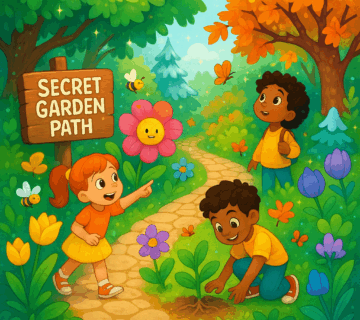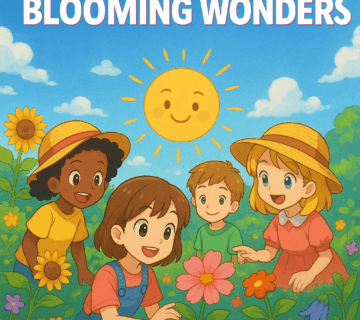What Your Child Can Learn from “Dancing Daisies” – A Parent’s Guide to The Magic Garden
Subscribe & Get Free E-books!
Subscribe to our channel and fill out the form below to receive exclusive free e-books directly in your inbox.
Welcome to the magical world of Dancing Daisies.
In Episode 03 of The Magic Garden, your child steps into an enchanting adventure filled with dancing flowers, buzzing bees, and fluttering butterflies. Beyond the colorful animation and charming characters, this episode delivers valuable educational lessons about plant science and the environment. This blog post breaks down the core concepts so you can continue the learning experience with your child at home.
Lesson 1: Heliotropism — How Flowers Follow the Sun
In the episode, Benny the Bear and his friends discover that the daisies turn their heads toward the sunlight. This fascinating behavior is known as heliotropism.
What is Heliotropism?
Heliotropism is when certain plants move their flowers or leaves to follow the sun throughout the day. This movement helps them capture as much sunlight as possible, which is essential for photosynthesis — the process plants use to make food.
Reinforcement Activity for Home:
-
Plant sunflowers or daisies in a sunny spot and observe them daily.
-
Let your child draw how the flower changes position from morning to evening.
-
Track sunlight patterns using paper and a pencil to draw shadows at different times of the day.
Lesson 2: Pollination — How Bees and Butterflies Help Plants
Fiona the Fox introduces the idea that bees and butterflies are not just pretty visitors in the garden — they are essential pollinators.
What is Pollination?
Pollination is the process of transferring pollen from one flower to another. It allows flowers to produce seeds and grow new plants. Bees, butterflies, and other insects help make this possible as they move from flower to flower collecting nectar and spreading pollen.
Discussion Questions for Kids:
-
Why do bees visit flowers?
-
What sticks to their bodies when they land on flowers?
-
How does this help the flowers grow new seeds?
Home Activity: Become a Pollinator Observer
Encourage hands-on discovery by turning your backyard or a local park into a nature classroom.
Steps to Try:
-
Locate an area with blooming flowers.
-
Sit with your child quietly and observe insect visitors for 10 to 15 minutes.
-
Count how many bees, butterflies, or other insects you see.
-
Record the findings and let your child draw or describe the insects.
-
Discuss which flowers were visited most often and why that might be.
Visit CartoonKidsTV.com for a free printable observation worksheet to guide this activity.
Bonus Feature: Interactive Pollinator Quiz
After watching the episode, test your child’s knowledge with a short quiz:
-
What is heliotropism?
-
What do bees collect from flowers?
-
Why are pollinators important?
Encouraging children to explain what they’ve learned in their own words strengthens their understanding and builds vocabulary.
Why This Episode Matters
Children ages 4 to 8 are naturally curious and eager to explore their environment. Dancing Daisies nurtures that curiosity by:
-
Encouraging scientific thinking through observation and questions
-
Promoting environmental awareness and respect for nature
-
Supporting hands-on learning with real-world activities
The young narrator adds relatability and engagement, while the episode’s storytelling format reinforces learning in a fun and memorable way.
Continue the Magic at Home
Subscribe to The Magic Garden on YouTube and explore more episodes that dive into soil science, weather, seed growth, and the wonder of outdoor exploration.
Visit CartoonKidsTV.com for:
-
Printable worksheets
-
Bonus learning activities
-
Parent and teacher resources
-
Weekly updates
Follow Cartoon Kids TV on Facebook, Instagram, and Pinterest for tips and ideas to keep your child’s love of learning growing every day.
With every flower, buzzing bee, and new discovery, your child learns that science is alive — right in their own backyard.



No comment